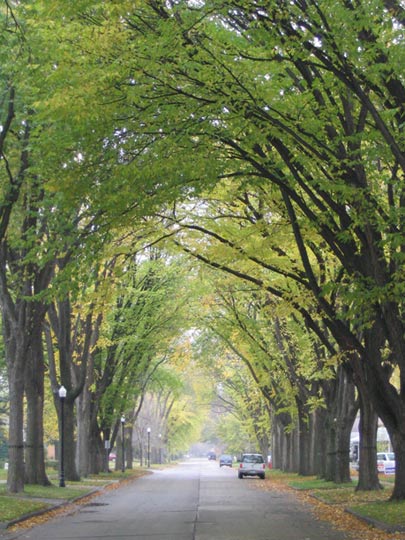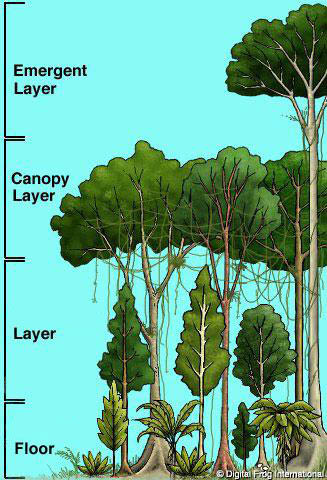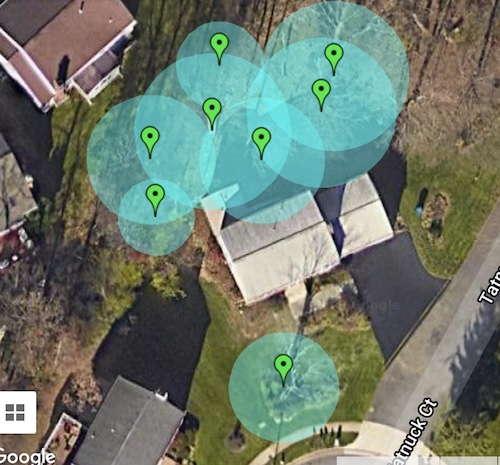Ecosystem Value of Canopy Shade Trees
By Ann M. Mason, Fairfax Master Gardener
 Have your neighbors told you they dislike canopy trees? Mine have. In fact, one neighbor cut down all mature trees in their front and back yard to avoid the possibility of trees falling on their home! Most of these trees were well over 70 to 100 years old and stood between 50 to 80 feet (15 – 25 M) tall.
Have your neighbors told you they dislike canopy trees? Mine have. In fact, one neighbor cut down all mature trees in their front and back yard to avoid the possibility of trees falling on their home! Most of these trees were well over 70 to 100 years old and stood between 50 to 80 feet (15 – 25 M) tall.
Apparently, my neighbor is not unusual. Over recent years, urban foresters have reported that residents tend to avoid planting canopy trees. Instead, they are planting understory trees as the tallest tree on residential properties.
As gardeners, we know that if we consider our individual yards as ecosystems, we can provide habitats for a diverse population of native bees, birds and other indigenous wildlife, especially if we select native plants. The gardener benefits from diverse habitats since troublesome insects are kept in balance by beneficial insects, birds and wildlife. The result? Less work for the gardener.

Layers in an Ecosystem
Creating an ecosystem means planting a multi-leveled landscape that contains habitats for a wide variety of birds, insects and wildlife. This includes canopy trees, understory trees, shrubs, herbaceous plantings and groundcovers. In short, gardeners need canopy trees to enhance our ecosystems. Gardeners are aware that beneficial insects need a continuous green corridor from one yard to another to provide forage and habitat so the beneficial species can thrive and remain residents in the neighborhood. The benefit to the homeowner is a landscape that enhances property values, a win for both the ecosystem and for the homeowner!
Urban forestry planners, arborists and civic authorities look at our collective yards under an Urban Forestry and Urban Tree Canopy lens. They report that at the community level, trees play a large positive role in stormwater management, enhanced property values, energy savings, air quality improvements and carbon dioxide reduction. Individual home properties benefit as part of the collective good.
While state, county and city planners may be looking at tree canopy under an Urban Tree Canopy program, this article explores the benefits and choices of canopy trees for individual home plots. In the time of changing climate and the possible temperature rise, homeowners who plant canopy trees can, in time, gain respite from our steamy Mid-Atlantic summer peak temperatures. Scientists report that under shade trees, summer temperatures drop by 10 to 20 degrees F (-12 to -6 C).
Right Tree — Right Place
It is heartbreaking to see a healthy canopy tree — a long term investment — cut down because it was planted in the wrong spot and now is seen as a threat rather than a benefit. How does the gardener achieve planting the right tree in the right place?
Let us look at some of the guidelines for planting trees — especially canopy trees. Virginia Tech defines trees by height: canopy trees include those that are 50 feet (16 M) or taller in height; medium trees have a mature height between 25 and 50 feet (8 – 16 M); small trees mature at heights of 15 to 25 feet (5 – 8 M).
Right tree — Right Place starts with gardeners imagining the space the mature tree needs, including the size of the canopy and root system, when compared to the available planting space and neighboring properties. The Arbor Day Foundation, arborists and other university extension scientists recommend space guidelines for planting trees. These experts recommend that gardeners plant trees at least 3 feet from walkways and driveways.
| Arbor Day Foundation Tree Planting Guidelines | |||
| Expected Mature Tree Height | Spacing between Plantings | Minimum Space from Wall of 1-Story Building | Minimum Space from Corner of 1-Story Building |
| Small trees (30′ or less) | 6-15′ | 8-10′ | 6-8′ |
| Medium trees (30-70′) | 30-40′ | 15′ | 12′ |
| Large trees (70′ or more) | 40-50′ | 20′ | 15′ |
Many gardeners use a process to pre-visualize the mature tree. I recruit another person to hold a long stick, the surrogate for a tree, upright in my choice location(s). Walking around the yard to view the surrogate tree from various vantage points, I imagine the mature tree. How broad is the canopy and the shade pattern in summer and winter? How will it frame my home or other structures? Will it limit or enhance visibility from the street? What is the soil type, water conditions, utility lines, etc. The questions go on. If you watched me, you would see me with a tape measure making sure that I have identified the constraints of my site. Only then do I go searching for a tree. Afterall, a healthy tree makes me happy. I do not want to fuss with the challenges of continually nursing an inappropriate tree.
Since a tree is a long term investment, my preference is to select a native tree, hearty to my zone 7 garden, that will settle in and thrive in my location and its environmental conditions. There are many candidate trees. Defining my space and environmental conditions — my homework — provides me base information to then go to sites like Virginia Tech’s Virginia Urban Street Tree Selector and i-Tree.

i-Tree Design Showing Canopy Sizes
i-Tree is a series of science-based tools developed by USDA Forest Service, Davey Tree Expert Company, The Arbor Day Foundation, arborist groups and others. One of these tools, i-Tree Design, is a web-based software tool that offers the gardener a visual estimation of the canopy the growing and mature tree can cast on an individual plot of land. It also estimates comparative energy reduction benefits if the gardener is trying to decide among various candidate trees.
Considerations for Selecting Candidate Trees
In addition to considering space requirements that are in scale with the home, site and other structures, gardeners may want to consider other factors including:
- Few or no insect or disease problems. If trees have known problems, gardeners need to prepare adequate control measures.
- Native and hardy for the growing zone. Northern Virginia is in US Department of Agriculture Hardiness Zone 7.
- Expected lifetime. Some fast growing trees have a shorter life span.
- Detritus issues. Some trees have messy fruit or seed pods or shed twigs and small branches.
- Soil conditions. Select tree for known environmental considerations at the planting site including tolerance for road salt, summer heat, water or drainage issues and soil type.
There are many books and websites to help the gardener select a tree for our Zone 7 gardens located in Virginia’s Piedmont District. Some of my favorites include Plant NOVA Natives website that provides easy to use information about sun, soil, height and other information. Virginia Department of Conservation and Recreation has a list of native plants recommended for the Virginia Piedmont area, and Virginia Tech Dendrology provides botanical fact sheets on candidate trees and other plants. The Virginia Tech Dendrology site identifies whether the plant is a native, nonnative or nonnative and also considered invasive in our hardiness zone. Virginia Cooperative Extension publication 426-610 offers a table rating seven key characteristics to help the gardener select a canopy tree.
Some candidate trees to get the gardener started include:
- Canopy trees, e.g., oaks, hickories, maples, ash, honey locust and yellow poplar, also called tulip tree, are the top layer of vegetation. These trees capture most of the sunlight and rain and provide protection from wind and storms. The branches and leaves of canopy trees make a leafy roof shading the ground below. Choosing a tall tree with a high branching habit can frame a structure to allow sight of the home and landscape.
- Medium trees, e.g., flowering dogwood, horse chestnut, yellowwood, red maple and river birch, tend to be in scale with low 1-story homes.
- Small trees, e.g., crabapple, redbud, serviceberry, crape myrtle, green hawthorn and American hornbeam.
There is no one best tree for a yard. With a bit of homework and pre-visualization, a gardener can select a tree that helps create the ecosystem habitat that both wildlife and humans can enjoy.
Resources
• Tree Placement on Home Grounds, Christopher J. Starbuck, Dept of Horticulture, University of
Missouri Extension
• Tree Canopy Spread & Coverage in Urban Landscapes, Virginia Tech Urban Forestry and Virginia
Nursery and Landscape Association
• Virginia Urban Street Tree Selector, Virginia Tech Urban Forestry
• i-Tree, US Forestry Service and others. Look for the i-Tree Design tool in this suite of tools.
• Native Tree Choices for Northern Virginia, Plant NOVA Natives
• Selecting Landscape Plants: Shade Trees, Diane Relf and Bonnie Appleton, Virginia Cooperative
Extension Publication 426-610